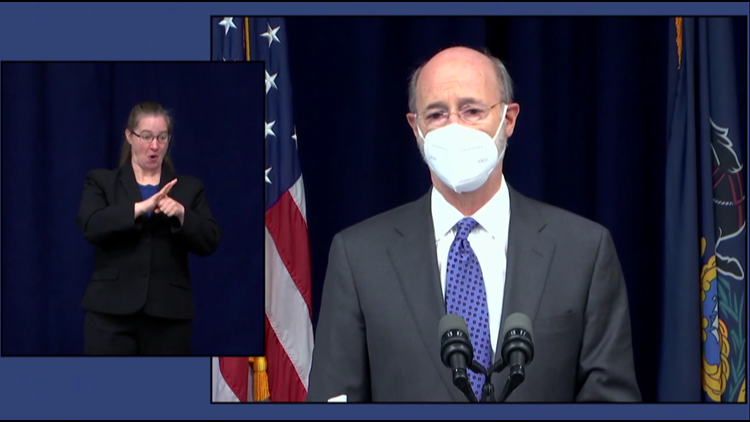HARRISBURG, Pa. — Governor Tom Wolf on Tuesday signed the 13th renewal of his January 2018 opioid disaster declaration to help the state fight the opioid and heroin epidemic, his administration announced.
The declaration was the first of its kind for a public health emergency in Pennsylvania, and "proved to be an important tool to allow the state to respond quickly, adapt to developing needs, increase access to treatment and save lives," the administration said.
The declaration allows the state to loosen regulations and work outside of typical procedures to expedite aid and initiatives to help those suffering from opioid use disorder and those who work to prevent and treat it, the administration said. It also allows agencies more flexibility to coordinate and share resources to address the changing needs of communities throughout the commonwealth.
“The opioid and heroin epidemic is an ongoing public health crisis, one that requires immense coordination of staff and resources to save lives and promote healing,” Wolf said in a press release. “Public health emergencies like this one are complex disasters that require a concerted, sustained response from the state.
“I am proud of the work done by the Opioid Command Center since 2016. By leveraging the diverse strengths and skillsets brought together by this group, we have been able to make great strides in saving lives and reducing negative outcomes for those suffering with a substance use disorder. The work done by the Opioid Command Center continues to change lives and communities in the commonwealth, and it is only possible because of this disaster declaration.”
Under the disaster declaration, work to address the opioid crisis focuses on three areas: prevention, rescue and treatment.
Efforts over the past several years, working with state agencies, local, regional and federal officials, have resulted in significant action to address the opioid crisis, the Wolf administration said, citing the following examples:
- In September, Governor Wolf and DDAP announced the launch of Life Unites Us, an anti-stigma campaign, utilizing social media platforms to spread real-life stories of individuals and their family members battling substance use disorder, live and recorded webinars detailing tools and information necessary to effectively reduce stigma to more than 350 community-based organizations focused on SUD prevention, treatment, and recovery throughout Pennsylvania, and a web-based interactive data dashboard detailing the progress of the campaign.
- The Wolf Administration called on all Pennsylvanians to carry naloxone.
- Physician General signed an updated naloxone standing order permitting community-based organizations to provide naloxone by mail.
- The PDMP has reduced opioid prescriptions by 36.6 percent and has virtually eliminated doctor shopping.
- The number of people receiving high dosages of opioids (defined as greater than 90 morphine milligram equivalents per day) has dropped 58.6 percent since the PDMP launched in August 2016.
- The Opioid Data Dashboard and Data Dashboard 2.0 has provided public-facing data regarding prevention, rescue and treatment.
- 11 Pennsylvania Coordinated Medication Assisted Treatment (PacMAT) programs are serving as part of a hub-and-spoke model to provide evidence-based treatment to people where they live, with just under $26 million dedicated into the centers.
- More than 45 Centers of Excellence, administered by the Department of Human Services, provide coordinated, evidence-based treatment to people with an opioid use disorder covered by Medicaid. The COEs have treated more than 32,500 people since first launching in 2016.
- The waiver of birth certificate fees for those with opioid use disorder has helped more than 5,600 people, enabling easier entry into recovery programs.
- A standing order signed by Dr. Rachel Levine in 2018 allowed EMS to leave behind more than 2,400 doses of naloxone.
- Education has been provided to more than 9,500 prescribers through either online or face-to-face education.
- 882 drug take-back boxes help Pennsylvanians properly dispose of unwanted drugs, including 178,540 pounds of unwanted drugs in 2019. 2020 data is not yet available because of COVID.
- The Get Help Now Hotline received more than 46,000 calls, with more than half of all callers connected directly to a treatment provider.
- The state prison system has expanded their Medication Assisted Treatment (MAT) program, which is viewed as a model program for other states.
- A body scanner pilot project was successful in reducing overdoses and violent crime in a number of facilities. Body scanners are in place in more than 30 locations and are currently being expanded to additional facilities.
- Several agencies have worked together to collaborate on the seizure and destruction of illicit opioids across Pennsylvania.
- Education and training on opioids have been provided to schools. Future plans are in place to make opioid education a standard component of school-based training.
- The coordination with seven major commercial providers has expand access to naloxone and mental health care, while also working to make it more affordable.
- Naloxone has been made available to first responders through the Pennsylvania Commission on Crime and Delinquency since November 2017, with more than 72,000 kits made available and more than 16,241 overdose reversals reported through the program. More than 6,600 of those saves occurred in 2019.
- EMS have administered more than 49,000 doses of naloxone and more than 10,000 doses were made available to members of the public during the state’s naloxone distribution last year.



